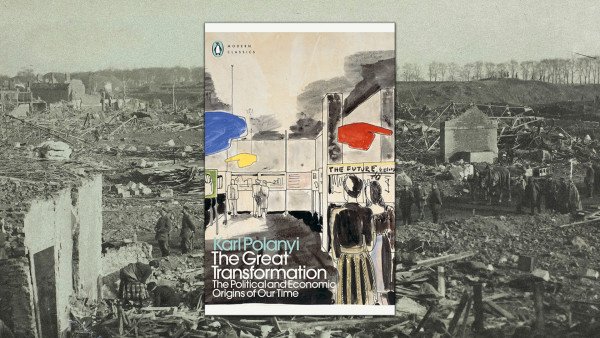Karl Polanyi’s 1944 work, The Great Transformation: The Political and Economic Origins of Our Timeexposes the myths of laissez-faire, which remain widespread in the West and elsewhere.
By looking at economic and other transformations during the Industrial Revolution and beyond, he showed that there is nothing inevitable or “natural” about free markets, and that the ideological belief that they can solve most economic problems is utopian and dangerous.
JM Keynes, a leading economic thinker of the last century, believed that those in authority were summarising the ideas of “some academic hack of a few years ago”. Indeed, his ideas underpin much of today’s economic policy.
However, unlike Keynes, who was an apologist for some form of capitalism, Polanyi’s less remembered “scribbles” show that market fundamentalism, the ideology of competition and the commodification of social relations contributed to weakening societies rather than enriching them, ultimately leading to the upheavals of 1914-45 and beyond.
Today, “the same risk exists,” according to French economist Thomas Piketty.
With the global retreat of the United States and its free market ideology, now is the time to rethink market freedom.
Polanyi argues that the distinctive feature of the “market society” underpinned by free enterprise is a change in economic mentality.
According to him, due to industrialization, competitive markets were created to change social trends through institutions that aimed at a self-regulating market economy.
From industrialization to modern crises
The expansion of the liberal mentality of capitalism also fundamentally altered economic relations between people. After industrialization, the myth of human nature’s propensity for free trade spread.
Polanyi argues, by contrast, that an essential element in the evolution from a pre-modern to a market economy was the alteration of human economic mindsets, from one based on local social relations and institutions to transactions idealized as rational and separate from their previous social context (this is reminiscent of J.K. Galbraith, another great economist of the last century, who focused on the rise of Western wealth after World War II and presented it as a qualitative and mixed change, not just a desirable quantitative phenomenon of higher incomes and more consumption).
Polanyi refutes liberal theories about the rise of capitalism by arguing that laissez-faire was planned. He does not deny that the self-regulating market has brought about enormous material wealth in many cases, but suggests that this approach is too narrow.
The market, Polanyi points out, once it regards labour and land as commodities, subordinates the substance of society to its laws. This, Polanyi argues, results in massive social dislocation, ultimately leading to spontaneous movements of society towards self-protection.
The changes Polanyi analysed implied the destruction of the social order that had reigned before the Industrial Revolution.
A central aspect of the change was that land and labor would now be sold openly at market-determined prices, rather than allocated according to tradition or some other non-market criterion.
However, the book also presents his belief that market society is unsustainable because it is destructive to humanity and its natural contexts.
Thus, a Polanyi moment eventually occurs when social protectionism begins to overtake marketization due to market collapse, as happened after the 2008 financial crisis and during the COVID-19 pandemic.
Reflections on shock therapy and IMF reforms
From a contemporary global perspective, American economist Joseph Stiglitz favours Polanyi’s explanation of market liberalisation, arguing that the failures of “shock therapy” in Russia after the Cold War and the shortcomings of the International Monetary Fund (IMF) reform packages echo Polanyi’s arguments.
Stiglitz also points out the difficulty of market liberalisation, as it demands unrealistic flexibility as the poor are forced to accept austerity. (The Bretton Woods system, which attempts to entrench liberalism globally, among other things through the IMF, was launched the same year as The great transformation (was published.)
Polanyi’s analysis helps explain why the revival of free market ideas led, and continues to lead, to such glaring failures as persistent unemployment, rising inequality, and financial crises.
He witnessed such upheavals in his own time, from the First World War to the rise of Communism, the onset of the Great Depression and the beginning of the Second World War, which was preceded by the rise of fascism.
References to Palestine
Curiously, a place of the latter that he mentions in The great transformation It was Palestine.
For him, a European Jew directly affected by Nazi ideology, Zionism represented a regression towards fascist isolation.
In 1934, Polanyi strongly repudiated the Zionists. “I will fight,” he wrote, “against the revival of the ghetto spirit that haunted our ancestors.”
The unfortunate result of the fascist-Zionist affinity he identified is now even more evident in the Israeli aggression.
In conclusion, The great transformation It is a correction to the current widespread global economic interpretation (an example of what Galbraith called the conventional wisdom) promoted by the United States and imposed throughout the world.
As such, the book should be read by economists, although non-economists should not attempt to read it lightly.
However, whatever the reader’s origin, The great transformation resonates today, making this reissue (with a new introduction) timely.
Riad al Khouri is an independent Jordanian economist
Follow him on LinkedIn: Riad Al Khouri
#Polanyis #Great #Transformation #Free #Market #Myth
